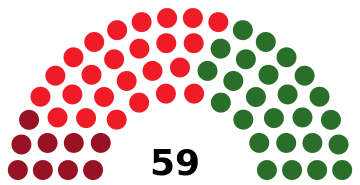Madrid City Council election, 1979
| | |||||||||||||||||||||||||||||||||||||||||||||||||||
| |||||||||||||||||||||||||||||||||||||||||||||||||||
| |||||||||||||||||||||||||||||||||||||||||||||||||||
| |||||||||||||||||||||||||||||||||||||||||||||||||||
The 1979 Madrid City Council election was held on Tuesday, 3 April 1979, to elect the 1st Madrid City Council, the unicameral local legislature of the municipality of Madrid. At stake were all 59 seats in the City Council, determining the Mayor of Madrid.
The Union of the Democratic Centre (UCD) emerged as the most voted party, but in a seat tie with the second force, the Spanish Socialist Workers' Party (PSOE), at 25 seats. As neither had an absolute majority of seats, it was up to the Communist Party of Spain (PCE) 9 seats to decide which party was to govern in Madrid.
Finally, an agreement between the PSOE and PCE resulted in Enrique Tierno Galván being named as the first democratically elected Mayor of Madrid.
Electoral system
The number of seats in the Madrid City Council was determined by the population count. According to the municipal electoral law, the population-seat relationship on each municipality was to be established on the following scale:
| Inhabitants | Seats |
|---|---|
| <250 | 5 |
| 251–1,000 | 7 |
| 1,001–2,000 | 9 |
| 2,001–5,000 | 11 |
| 5,001–10,000 | 13 |
| 10,001–20,000 | 17 |
| 20,001–50,000 | 21 |
| 50,001–100,000 | 25 |
Additionally, for populations greater than 100,000, 1 seat was to be added per each 100,000 inhabitants or fraction, according to the most updated census data, and adding 1 more seat if the resulting seat count gives an even number. As the updated population census for the 1979 election was 3,355,720, the Madrid City Council size was set to 59 seats.
All City Council members were elected in a single multi-member district, consisting of the Madrid municipality, using the D'Hondt method and a closed-list proportional representation system. Voting was on the basis of universal suffrage in a secret ballot. Only lists polling above 5% of valid votes in all of the municipality (which include blank ballots—for none of the above) were entitled to enter the seat distribution.
The Spanish municipal electoral law established a clause stating that, if no candidate was to gather an absolute majority of votes to be elected as mayor of a municipality, the candidate of the most-voted party would be automatically elected to the post.[1]
Results
 | ||||||
| Party | Vote | Seats | ||||
|---|---|---|---|---|---|---|
| Votes | % | ±pp | Won | +/− | ||
| Union of the Democratic Centre (UCD) | 632,329 | 40.29 | − | 25 | − | |
| Spanish Socialist Workers' Party (PSOE) | 619,772 | 39.49 | − | 25 | − | |
| Communist Party of Spain (PCE) | 230,651 | 14.69 | − | 9 | − | |
| Workers' Revolutionary Organization (ORT) | 37,396 | 2.38 | − | 0 | − | |
| Spanish Falange of the JONS (FE-JONS) | 25,038 | 1.60 | − | 0 | − | |
| Spanish Socialist Workers' Party (historic) (PSOE-H) | 5,317 | 0.34 | − | 0 | − | |
| Communist Unification of Spain (UCE) | 5,251 | 0.33 | − | 0 | − | |
| Spanish Communist Workers' Party (PCOE) | 5,241 | 0.33 | − | 0 | − | |
| Communist Movement-Communist Left Organization (MC-OIC) | 2,401 | 0.15 | − | 0 | − | |
| Socialist Party (PS) | 2,298 | 0.15 | − | 0 | − | |
| Spanish Liberal Party (PLE) | 2,132 | 0.14 | − | 0 | − | |
| Revolutionary Communist League (LCR) | 1,784 | 0.11 | − | 0 | − | |
| Blank ballots | 0 | 0.00 | − | |||
| Total | 1,569,610 | 100.00 | 59 | − | ||
| Valid votes | 1,569,610 | 100.00 | − | |||
| Invalid votes | 0 | 0.00 | − | |||
| Votes cast / turnout | 1,569,610 | 65.98 | − | |||
| Abstentions | 809,331 | 34.02 | − | |||
| Registered voters | 2,378,941 | |||||
| Source: Ministry of the Interior | ||||||

.jpg)
.jpg)